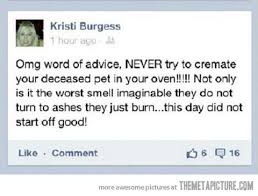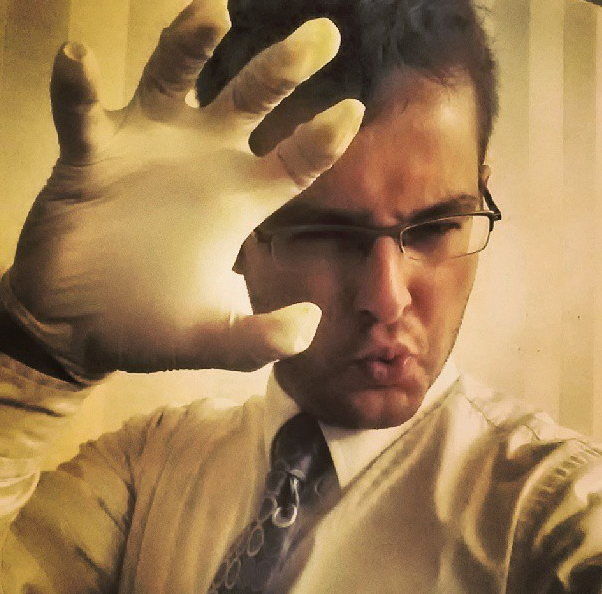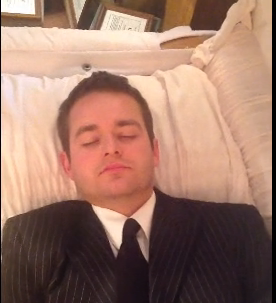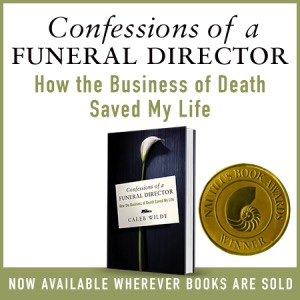Embalming vs. Cremation
10 Things You Should Know about Cremation

© 2005 Justin Seabrook-Rocha, Flickr | CC-BY-SA | via Wylio
One. No such thing as DIY.
In many counties in the US, it’s difficult to get a permit to burn leaves, yet alone a human body. There are DIY funerals and green burials (which have a large degree of family and friend involvement), but when it comes to cremation you’ll need to use a cremation provider.
Many cremation providers will allow you to witness the cremation (the retort isn’t made of glass, so you won’t see anything nightmarish). Some cremation providers will even allow you to activate the retort and start the cremation.
In some European countries, it’s the custom to wait at the crematory until the cremation is finished; once complete, you take the cremated remains home with you while they’re still warm.
Two. Crestone, Colorado is the place to go …
… if you want to (legally) cremate outdoors on a pyre. The body is surrounded by juniper logs and branches and set aflame. It’s the only outdoor funeral pyre in the US and can only be used by local residents. It’s offered by Crestone End of Life Project, which asks for a $425 donation for each cremation. Per US-Funerals.com, “It takes about four to five hours for a body to burn completely, and as there is no way to separate the human ashes from the wood ash, the family receive about five gallons of ashes.”
Three. Price Standards
One of my major gripes with the funeral industry is the utter lack of price standardization. You can go to a funeral home and pay $15,000 for a funeral; and you can drive down the street to another funeral home and get the very same funeral for half the cost.
The nice thing with cremation is that there is some degree of price standardization; enough that you should be able to distinguish between a legitimately fair priced cremation and a total rip-off. If you JUST want a cremation (what funeral directors call a “direct cremation with no funeral service”), you should be able to do so for under $3,000. In some places, you can have a direct cremation for under $1,000.
Four. Pacemakers Explode
They will explode when cremated and can cause upwards of $10,000 of damage to the retort. So, pacemakers need to be removed before cremation. And don’t worry, the funeral directors/cremationists will do the removal for you.
Five. The Body Doesn’t Need to be Embalmed
As a way to pad their pockets, bad funeral directors want to make you think that embalming is ALWAYS required. It isn’t. In fact, the Federal Trade Commission’s “Funeral Rule” states explicitly that funeral directors need to disclose that embalming is your choice. And if you want cremation, there’s absolutely no reason for embalming. But, be aware, that if you use a funeral home and want a public viewing, you’ll likely need your loved one embalmed.
Six. But you Can Have Embalming, a Public Viewing and then Cremation
This option has gained some popularity because it allows for a public viewing and is less expensive than a traditional burial. With this option, you don’t need to purchase a casket (most funeral homes have rental caskets), you don’t need to purchase a grave lot (although you still can if you wish), you don’t need to purchase a vault and you don’t need to pay for the opening and closing of the grave. In Rob Lowe “Parks and Rec” voice: It can literally save you thousands .
Seven. Super Obese Persons May Cost More
“Super obesity” is the class above “morbid obesity”. Super obesity is the sad state where the victim can barely move or function. These types of obesity cases can rarely be cremated in a regular retort and will often have to be cremated in a larger, more specialized retort … which can (and often does) cost more.
Eight. You Don’t Need to Buy a Cremation Casket
Crematories (all?) require that the body is placed in some protective container before it is cremated. Our funeral home simply uses a body bag (a body bag that comes at no charge to the family). In fact, funeral directors are breaking the “Funeral Rule” if they tell you that state and/or local law require a casket for cremation.
Nine. Bodies are not cremated together.
There isn’t a two for one special. One at a time.
Ten. This is a bad idea:
Eight Photos of the Embalming Process
WARNING: This post contains photos of the embalming process. If you are sensitive to photos of deceased persons and bodily fluids, please do not continue reading. The purpose of this post isn’t to salaciously satisfy your morbid appetite. My hope is that it can create a better (albeit fundamental) understanding of the process of embalming.
All of these photos have been sourced from the YouTube video “Modern Embalming Practice” by German embalmer Thomas Müller.
If you’re interested in the depth of the funeral business, this book will bury you six feet deep.
Ten Things We Use When Embalming
Some of these photos may be disturbing. All of these photos have been sourced either from the internet.
1. This is a needle injector, which is effectively used for mouth closure. We use this to set the features before we embalm. Once the mouth and eyes are closed (see number 2), then we can think about starting arterial embalming. 
The needles are the shiny silver things attached to the shiny gold things (we only use two at a time):
One needle is anchored into the maxilla and another needle is anchored into the mandible. The wires that are attached to the needles are then twisted together until the mouth is “cranked” shut.
2. These round spiked spheres are called “eye caps”. They are placed under the eye lids and essentially grab the eyelids and hold them in place, keeping the eyes closed.
You can also use these as very small Frisbees.
3. These are examples of the scalpels that we use for embalming. They are sharp.
Many embalmers use the right carotid artery for embalming and the jugular vein for drainage of the blood. We use the scalpel to cut the neck and find said artery and vein.
The scalpels can also be used to cut other things, like steak and pork. But, it’s probably not good to use a used embalming scalpel on your steak. That’s an amateur move.
4. This is an Aneurysm hook.
We use this little guy to raise the artery and the vein out of the neck.
5. The arterial tube gets slipped into the incised artery.
6. Embalming Machine (Drum roll please)
 That black rubber tube gets placed onto the arterial tube and the embalming fluid is pumped into the arterial system.
That black rubber tube gets placed onto the arterial tube and the embalming fluid is pumped into the arterial system.
You can also use embalming machines for various other interests. Like a fish tank / plant holder. Or a punch bowl.
7. The drainage tube is slid into the jugular vein. When the embalming machine forces the embalming fluid into the arterial system, that fluid forces the blood out via the veins and the drainage tube.
8. Arterial embalming only reaches the parts of the body that are connected to the arterial system. The intestines, stomach, lungs, etc. are left relatively untouched. We then remove all the content of the stomach, lungs, etc. through a long needle like suction thingy called a “trocar”.
9. After the stomach, lungs, etc have been cleaned out, we then inject cavity fluid. After that has been done, we screw in a trocar button in the hole left by the trocar.
10. Finally, during this whole process, we use gloves. I prefer my latex gloves in the “Fierce Beige” color because it matches my personality.
Embalming: The Religion of Funeral Service?
Death rites and rituals are hardly ever static. Change is the constant in both life in death. And so it is that change is here for the funeral business in the United States. We sit in liminality.
The “traditional funeral” (aka embalming and burial [as defined by the FTC]) in the US is becoming outdated for many reasons. It’s being replaced by cremation and (hopefully) a more natural orientation.
Yet, some (many?) funeral directors here in the United States and elsewhere are still preaching the Gospel that the presentation of an embalmed body is the foundation of the funeral business. Our preaching is so religious that when someone questions the value of embalming, some funeral directors kinda freak out like we’re questioning the very existence of God.
If embalming is the foundation of our practice, it’s a very shaky foundation. Here are ten reasons we probably shouldn’t deify embalming.
One. Embalming Will Slowly Die
Cremation is on the rise. Arizona has a 60% cremation rate. And the projections are that the rest of the country will eventually catch up.
Embalming and burial is “the traditional funeral” for a generation that is dying. And we should serve that generation and their needs. But, when that generation is dead, most will eventually opt for cremation. Embalming is more so a trend than an religion; and that’s an important distinction.
Two. Value Vs. Cost
There’s a difference between value and cost. People will pay for things that they see as valuable. And people are increasingly NOT seeing value in the traditional funeral to justify the cost of embalming, casket, vault and burial plots. Increasingly, people don’t have enough money for life, yet alone death. The lack of funds combined with a perceived lack of value is creating a smaller and smaller market for the “traditional funeral.”
Three. Botox
With the increasing rise of Botox, people are already embalmed and will look just as good in death. Have you seen Joan Rivers? Donatella Versace? Pete Burns? I’m just kidding. Botox has nothing to do with this conversation. Okay, bad attempt at humor. Moving on to the thesis of this post.
Four. The Gospel Isn’t True
I used to believe the Gospel of the “Traditional Funeral”. I was taught to believe the Gospel. That if you saw the body of the deceased you could repent of your death denial and place your faith in death acceptance.
Don’t get me wrong, I do see value in the traditional funeral. There is value in restoring the symbol of death. And, in many ways, the traditional funeral is a microcosm of the grief process. But the psychological value and sociological rites that come with embalming can be had from other types of disposition, especially when there’s more involvement from the friends and family of the deceased.
Five. Cremation Can be Converted
In funeral school, we were taught to fear this transition. We were taught that cremation and other alternative burial forms were THE ENEMY. They were the enemy to our bottom line (if people cremate, they wouldn’t need embalming, they won’t need a casket and they probably won’t need a vault). The ENEMY to our way of life.
AND, cremation and natural burial are the heresy to the Gospel. With cremation you just can’t repent and have faith. BUT, even cremation can be redeemed. We – at our funeral home – always give the family (and often encourage the family) the option to have a small private viewing before cremation. Allowing them the viewing helps their grief process AND allows them a more inexpensive funeral option.
Six. The Zombie Apocolypse
And there’s always THAT to worry about.
Seven. There’s Probably Better Psychological Benefits in Natural Burial
It just makes more sense that those who took care of the deceased in life should also do so in death. And when we (the so called funeral “professionals) are cut out, it may (probably) be a better aid in grief work to do it yourself.
Embalming helps confront death denial. But natural burial does it better because it often allows the true professionals to play their part.
Eight. Urbanization Creates Expensive Cemetery Space
One practical reason we can still bury casket, vault and body in the US is because we still have land. Where land is scarcer and urbanization is more of a reality, cremation is the pragmatic choice. As we become increasingly urbanized, and local cemetery space becomes more sparse, we will – by necessity – opt for cremation. For instance, in large towns in Europe the cremation rate is between 70 to 90% while a full burial is only reserved for the wealthy aristocracy who can afford grave plots.
Nine. We Live and Die in Transience
In times past, generation after generation lived and died in the same area, if not the same small town. Today our jobs, dreams and wanderlust have pulled our families and communities all through the US and the world.
In the past, you wanted to be buried with your people. And you see this in old cemeteries. Generation after generation of Suchandsuch family are all buried within a couple caskets lengths of each other. We live in transience and our desire to be buried with out people isn’t so easy anymore because our people are buried all … over … the country. And so we don’t bury with our people, we spread the ashes in an area that best represents the deceased.
Full burial just doesn’t have the same communal appeal that it did for older generations.
Ten. We Are Selling Ourselves Short
If we think embalming is the very best we have to offer the grieving masses, we’re missing out on our true potential. I think the value that funeral directors have to offer is much less “services provided” focused and much more rites and rituals focused, where we’re able to translate our experience with death and death rites into meaningful ritual. AND, if those meaningful rituals include embalming, then great.
In fact, I envision future funeral schools becoming much more focused on bereavement studies with the recognition that funeral directors are on the front line of the grief process. Our value, I believe, shouldn’t be solely in our ability to embalm (I still love you Jack Adams), but in our ability to help you through healthy rituals and aid in celebrating the life and death of your loved one.
I see a future where funeral directors — more than now — can stop serving our religion and start serving families. Because our religion is — and always should be — helping You.
Ten Things About Embalming
One. It’s weird.
Yes, we lay a nekked person on a table and take out their blood, replacing said blood with embalming fluid. Weird? Yes.
But so is cremation, sky burial, endocannibalism, famadihana and mummification.
Two. It does not preserve the body indefinitely.
You can’t dig up an embalmed body from 1920 and expect it to be a perfect specimen of unblemished human anatomy. It’s possible that the body is in good shape, but not probable.
The official definition from the American Board of Funeral Service Education states that embalming is “the process of chemically treating the dead human body to reduce the presence and growth of microorganisms, to retard organic decomposition, and to restore an acceptable physical appearance.”
Reduce, retard and restore. Mainly the restore part.
So … about Vladimir Lenin and his dead-since-1924 body that is still viewable today? Harry Potter magic and a few other tricks is the answer.
Three. In most states, what is pushed out of the body goes down the drain and out into public sewage.
Now you know.
Four. Embalming doesn’t promote the public health.
There’s an idea (possibly perpetuated by societal laws, originating back to Mosaic Law and certified in pandemics like “The Plague”) that you can catch death by hanging around a dead body.
For the most part, it’s just not true. They’re safe. Sure, you shouldn’t want to be all buddy-buddy with a dead body, but an unembalmed body won’t kill you. Dead bodies aren’t zombies
Five. It guarantees you won’t be buried alive.
If you fear getting cremated alive or buried alive, embalming guarantees neither of those things will happen. But if you live in a “First World” country, you don’t have to worry about getting buried or cremated alive. We’re pretty good at determining death. For the most part.
Six. It helps make the symbol of death look pretty.
The dead body is the symbol and it’s a symbol that needs to be seen. It needs to be seen for reasons of grief work and for death denial confrontation. Dr. Erich Lindemann (grief management pioneer) says that a defining characteristic of persons dealing with complicated bereavement is that they never saw the dead body of their loved one.
An embalmed body helps the symbol look good. There’s nothing wrong with that. It’s a good thing. In fact, at times it’s a beautiful thing.
Certainly, embalming isn’t necessary AT ALL to see the dead body. But, it can help.
Seven. Embalming fluid is not environmentally friendly.
The most environmentally friendly form of burial is a natural burial. Plain and simple. Cremation isn’t wonderful for the atmosphere. And embalming fluid isn’t wonderful for the ground.
Eight. Embalming isn’t the “Traditional Funeral”.
We didn’t do the whole arterial embalming thing until the mid-1800s. Before that it was all natural and dirt and fire and other things. The “traditional funeral” is actually rather non-traditional when you consider the sum history of Homo sapiens.
Nine. It is rarely required.
If you’re getting cremated, it’s OBVIOUSLY not required. For viewings and burials, local laws differ on embalming requirements (some areas require a body to be embalmed if it isn’t buried after it’s been dead for 10 days). Alabama, Alaska, and New Jersey require embalming if you’re transporting a body to their state (which is a stupid law). Various types of refrigeration are an alternative form of temporary preservation while awaiting a funeral service and/or viewing.
Ten: Embalming fluid shouldn’t be smoked.
Seriously. Don’t smoke wet. Embalming fluid is meant for dead people.





















